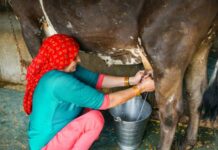New Delhi, May 23, 2020: Like Ponce de León searching for the Fountain of Youth, food manufacturers are always on the hunt for the next superfruit. While there is no exact definition of a superfruit, any fruit with a high antioxidant content — and thus potential to stave off the effects of aging — is a ripe candidate.
Some superfruits can also help reduce stress and might be ideal for today’s anxious consumers. Many fruits frequently used in dairy, including tart cherries, blueberries and raspberries, have gained superfruit status because they contain high levels of vitamins, minerals and antioxidants.
The novel superfruits explored in this column might be new to most U.S. consumers, but all three have been part of traditional medicine in various parts of the world for centuries. Major U.S. food corporations have recently taken steps to foster these superfruits through acquisition or incubator efforts.
Goldenberries
Goldenberries are bright orange-colored and closely related to the tomatillo. They contain high levels of vitamins A and C, which help to boost the immune system. They also contain withanolides, naturally occurring adaptogens that can help the body adapt to stress.
They are purported to improve digestive health and fight inflammation. A new research study (https://tinyurl.com/ychnuoe5) shows that extract of goldenberry might be useful in combating chronic obstructive pulmonary disease.
In 2018, Nestlé completed the acquisition of Terrafertil, a natural foods company and the main producer of goldenberry ingredients. The sweet and tart fruit is available in dried and powdered form. Potential applications include juices, smoothies and baby food.
The goldenberry has been used by South American tribes to treat asthma, malaria and rheumatism. Also known as the Inca berry, this fruit is native to Peru, Ecuador and Columbia, but can be grown in the Northeast and Midwest parts of the United States.
Aronia berries
Also known as black chokeberries, aronia berries contain abundant anthocyanins, which have been shown to provide an anti-inflammatory effect. A recent study (https://tinyurl.com/yd6z7xa7) found that they may be useful in reducing risk factors for atherosclerosis.
Kraft Heinz selected Poppilu, a new lemonade brand that incorporates aronia berries, as one of five companies in its new Chicago-based startup incubator. Tart purple aronia berries impart an antioxidant boost and a pink hue to the lemonade, which also boasts less sugar than many competing products.
Aronia berries were used by Native Americans to treat cuts and abrasions, cure and tenderize meat, and boost nutrition during the winter months. The shrubs are native to North America and can grow in USDA Zones 3 to 8. Aronia berry farms are springing up across the upper Midwest according to the reports published in dairyfoods.com.
Baobab fruit
Baobab, also known as the “tree of life,” grows in the Savannah drylands of sub-Saharan Africa. Its fruit has six times the vitamin C of oranges, 50% more calcium than spinach and more powerful antioxidants than acai and pomegranate. Baobab fruit pulp and leaves are rich sources of procyanidins and flavonol glycosides. Antioxidant and α-glucosidase inhibition activity assays confirm the classification of baobab as a superfruit.
The African company Makomas was awarded a $75,000 grant from PepsiCo via the MassChallenge accelerator. Makomas produces products that combine baobab fruit with ginger for teas and juices. The powdered fruit pulp can also be used in ice cream and various mixes. It is low-glycemic and a good source of fiber.
Baobab fruit pulp has been used in traditional African medicine as an anti-inflammatory, anti-dysenteric and immunostimulant (https://tinyurl.com/y84uw946). Although baobab is mostly grown in Africa, there are species native to Australia and India. The tree is hardy in USDA Zones 10 to 12 and is very drought-tolerant.
For cost optimization, pair a novel superfruit with a traditional fruit base or concentrate. Be sure to educate consumers by touting the history and benefits of your chosen superfruit on your company website.



























